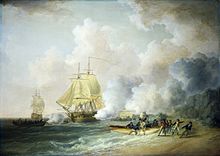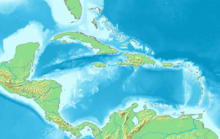| This article includes a list of general references, but it lacks sufficient corresponding inline citations. Please help to improve this article by introducing more precise citations. (September 2014) (Learn how and when to remove this message) |
| Battle of Martinique | |||||||
|---|---|---|---|---|---|---|---|
| Part of the War of the First Coalition | |||||||
 'The Capture of Fort Saint Louis, Martinique, 20 March 1794' painting by William Anderson | |||||||
| |||||||
| Belligerents | |||||||
|
|
| ||||||
| Commanders and leaders | |||||||
|
John Jervis Charles Grey |
Donatien-Marie-Joseph de Vimeur | ||||||
| Strength | |||||||
|
6,000 men 3 ships of the line 5 Frigates | 900 troops or militia | ||||||
  | |||||||
The Battle of Martinique was a successful British invasion of the French colony of Martinique in the West Indies during the French Revolutionary Wars. They continued to occupy the island until 1802, when the Treaty of Amiens restored it to French control.
Background
Prior to the invasion, war had broken out between the French Republic and Great Britain. The British government was contacted by French planter Louis-François Dubuc, who wished to place Martinique under British protection as the Republic's National Constituent Assembly was about to pass legislation which would abolish slavery in the French colonial empire; the legislation was passed the day before the British invasion of Martinique commenced. Fourteen days later, the British signed the Whitehall Accord on 9 February with counter-revolutionary French planters, which allowed them to keep their chattel property.
Invasion
On 5 February, a British fleet under the command of Royal Navy Admiral Sir John Jervis landed troops under the command of Sir Charles Grey on the island, which proceeded to capture the island from the Republicans in concert with French planters.
By 20 March, only Fort Bourbon and Fort Royal remained under Republican control. Jervis ordered the fourth-rate ship of the line HMS Asia, and the sloop, HMS Zebra to capture Fort Saint Louis. HMS Asia was unable to get close to the fort and Zebra went in alone, with her captain, Richard Faulknor. Despite facing heavy Republican artillery fire, Faulknor ran Zebra close under the walls. He and his ship's company then used Zebra's boats to land. The British stormed the fort and captured it. Zebra lost only her pilot killed and four men wounded. Meanwhile, the remainder of the British fleet captured Fort Royal and two days later Fort Bourbon capitulated.
Aftermath
The Governor General of Martinique at the time, Donatien-Marie-Joseph de Vimeur, surrendered to Grey. The British then occupied Martinique until the Treaty of Amiens returned the island to the French in 1802.
Citations
- ^ "No. 13643". The London Gazette. 22 April 1794. pp. 353–359.
- James (1837), Vol. 1, p. 218
References
- Fortescue, John. A history of the British Army, Volume 4
- James, William (1837) . The Naval History of Great Britain, Volume I, 1793–1796. London: Richard Bentley. OCLC 634321885.
This article about a battle in British history is a stub. You can help Misplaced Pages by expanding it. |
This article about a battle in French history is a stub. You can help Misplaced Pages by expanding it. |
- Battles of the French Revolutionary Wars
- Battles involving Great Britain
- Battles involving France
- History of Martinique
- Conflicts in 1794
- Invasions
- 1794 in the British Empire
- 1794 in the Caribbean
- Invasions by Great Britain
- Invasions of Martinique
- 18th century in Martinique
- British battle stubs
- French battle stubs